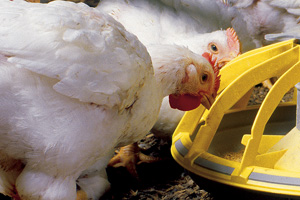Study: Camelina meal reduces FCR in broilers

This study compared the effects of graded levels of camelina meal and/or canola meal on digestibility, performance and fatty acid composition of broiler chickens.
A total of 180-day-old male broiler chicks were randomly assigned to one of the six treatments. The control diet was based on wheat and soybean meal and contained 15% canola meal. The experimental diets contained 3%, 6%, 9%, 12% or 15% camelina meal added at the expense of canola meal. Chromic oxide (0.35%) was added to all diets as a digestibility marker.
On the morning of day 22, birds were killed by cervical dislocation and their abdominal fat pad was obtained. The apparent total tract digestibility of dry matter and energy as well as nitrogen retention all declined linearly (p < 0.01) with increasing levels of dietary camelina meal. Weight gain (p < 0.01) and feed intake (p = 0.08) were linearly reduced as the level of camelina meal in the diet increased. Feed conversion ratio was also negatively affected by camelina meal (p < 0.01).
Birds fed diets containing 15% camelina meal had significantly higher (p < 0.01) levels of polyunsaturated fatty acids, total n-3 fatty acids, total n-6 fatty acids and a significantly lower ratio of n-6 to n-3 fatty acids (p < 0.01) than birds fed canola meal.
In conclusion, the inclusion of camelina meal in their diet significantly reduced the growth and feed conversion ratio of broilers compared with canola meal. However, the potential to incorporate n-3 fatty acids into carcass tissues may provide some justification for including camelina meal in poultry rations.













